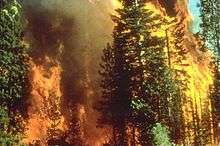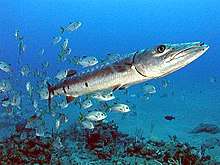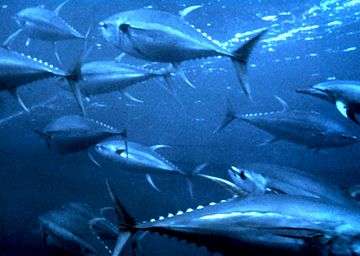Age class structure
Age class structure in fisheries and wildlife management is a part of population assessment. Age class structures can be used to model many populations include trees and fish. This method can be used to predict the occurrence of forest fires within a forest population.[1] Age can be determined by counting growth rings in fish scales, otoliths, cross-sections of fin spines for species with thick spines such as triggerfish,[2] or teeth for a few species.[3][4] Each method has its merits and drawbacks. Fish scales are easiest to obtain, but may be unreliable if scales have fallen off the fish and new ones grown in their places.[5] Fin spines may be unreliable for the same reason, and most fish do not have spines of sufficient thickness for clear rings to be visible. Otoliths will have stayed with the fish throughout its life history,[2] but obtaining them requires killing the fish.[6] Also, otoliths often require more preparation before ageing can occur.[5]

Analyzing fisheries age class structure
An example of using age class structure to learn about a population is a regular bell curve for the population of 1-5 year-old fish with a very low population for the 3-year-olds. An age class structure with gaps in population size like the one described earlier implies a bad spawning year 3 years ago in that species[citation needed].
Often fish in younger age class structures have very low numbers because they were small enough to slip through the sampling nets, and may in fact have a very healthy population.[7]
See also
- Identification of aging in fish
- Population pyramid
- Population dynamics of fisheries
References
- Wagner, C. E. Van (1978-06-01). "Age-class distribution and the forest fire cycle". Canadian Journal of Forest Research. 8 (2): 220–227. doi:10.1139/x78-034. ISSN 0045-5067.
- O’Sullivan, Sandra (2007). Fisheries Long Term Monitoring Program. Brisbane, Australia: Queensland Department of Primary Industries and Fisheries.
- Field, I.C., Meekan, M.G. & Bradshaw, C.J.A. (2009). Development of non-lethal methods for determining age and habitat use of sawfishes from northern Australia. Australia: Australian Department of the Environment and Energy.
- Helfman, Gene; Collette, Bruce B.; Facey, Douglas E.; Bowen, Brian W. (2009-04-09). The Diversity of Fishes - Biology, Evolution, Andecology 2E (PDF). Oxford: Wiley-Blackwell UK. ISBN 9781405124942.
- "MANUAL OF FISHERIES SCIENCE Part 2 - Methods of Resource Investigation and their Application". www.fao.org. Retrieved 2018-03-24.
- Lux, Fred E. "Age Determination in Fishes". Washington, DC, United States: United States Bureau of Commercial Fisheries. Available at http://spo.nmfs.noaa.gov/Fishery%20Leaflets/leaflet488.pdf. Accessed 24/03/2018.
- Haines, Terry A. (1990). Intensive Studies of Stream Fish Populations in Maine. Washington, D.C., USA: U.S. Environment Protection Agency, Office of Acid Deposition, Environmental Monitoring and Quality Assurance. p. 17.

